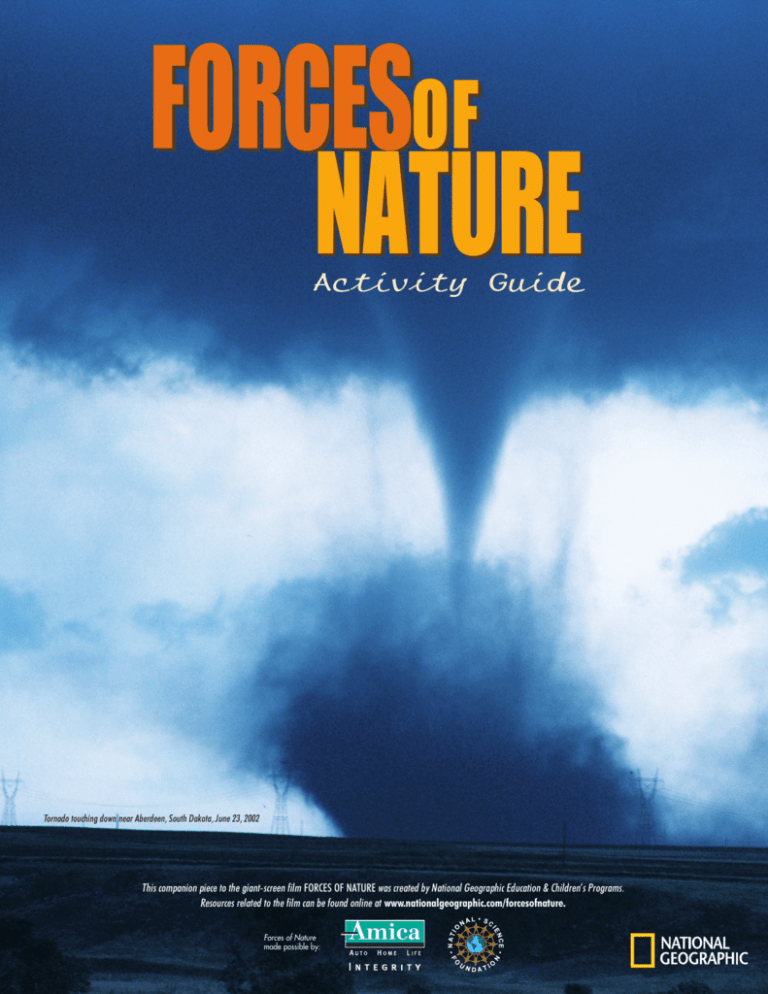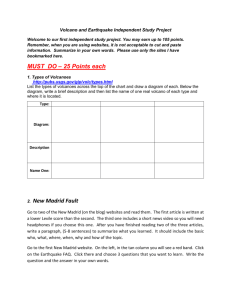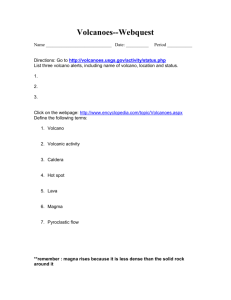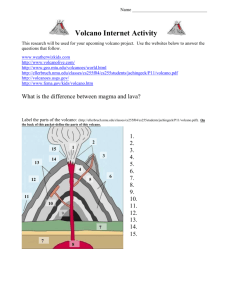
FORCESOF
NATURE
Activity Guide
Tornado touching down near Aberdeen, South Dakota, June 23, 2002
This companion piece to the giant-screen film FORCES OF NATURE was created by National Geographic Education & Children’s Programs.
Resources related to the film can be found online at www.nationalgeographic.com/forcesofnature.
Forces of Nature
made possible by:
ACTIVITY 1
Dr. Marie Edmonds
Look Around – Observe Like A Scientist
The scientists in the giant-screen film Forces of Nature — volcanologist Marie Edmonds,
geophysicist Ross Stein, and meteorologist Josh Wurman — study different natural
forces: volcanoes, earthquakes, and tornadoes. But, like all scientists, they’ve learned
to observe — to watch — very carefully. Josh Wurman tracks tornadoes, so he often
makes observations from a moving truck!
HOW CAN YOU OBSERVE LIKE A SCIENTIST?
q Track the weather. Collect and record information at the same time every day,
perhaps when you get home from school. Record your information in a Weather
Calendar. You can download and print calendars at:
— Teach Art at Home (www.teachartathome.com/WeatherChart.html)
— timeanddate.com (www.timeanddate.com/calendar/monthly.html)
What weather data should you collect? The sky’s the limit! Start with these suggestions,
then come up with your own ideas.
• Check the temperature using an outdoor thermometer. Note the sky conditions
(clear, cloudy, rainy, foggy). Is it calm or windy? Record the data (for example,
54oF, partly cloudy, very windy).
• Gather other information (for example, daily high and low temperatures,
humidity, wind speed, windchill) from TV, radio, newspapers, or online from
The Weather Channel at www.weather.com.
• Compare your weather with weather in another place. Keep a “double list” of
weather data on your calendar.
q EcoKids gives you more ideas about how to “Be a Weather Watcher” at
www.ecokids.ca/pub/eco_info/topics/climate/weather/index.cfm.
Now you are observing like a scientist.
Forces of Nature
made possible by:
Go online for information about the giant-screen film Forces of Nature: www.nationalgeographic.com/forcesofnature
PAGE 1
ACTIVITY 2
Tornado touching down near Aberdeen,
South Dakota, June 23, 2002
Look Closely – Check For Patterns
“Finding patterns is what it’s all about,” says Marie Edmonds, the volcanologist
featured in the giant-screen film Forces of Nature. Marie Edmonds and the other
scientists in the film — Ross Stein and Josh Wurman — look for patterns to help them
understand natural hazards and save lives. But you don’t have to live next to a
volcano to find patterns of nature — just look in your backyard.
WHAT PATTERNS OF NATURE CAN YOU FIND?
q Look out a window. Make a list or sketch the natural things you see — wildlife,
trees, flowers, water. Look again the next day. What is different? What would it look
like at night or in another season?
q Check out the “Largest Earthquakes in the World Since 1900” at
http://neic.usgs.gov/neis/eqlists/10maps_world.html. Where did these
earthquakes occur? Do you see a pattern? What was the magnitude of the largest quake?
q Explore cool images of hot spots at Volcano World at
http://volcano.und.nodak.edu/vwdocs/volc_images/volc_images.html. Are there
volcanoes on every continent? Do some regions have more volcanoes than others?
How do the patterns of volcanoes compare to the patterns of earthquakes?
q Find patterns in your observations. In your Weather Calendar (see page one),
write “Forecast” under today’s date. Jot down a prediction for tomorrow’s weather,
based on the current weather and patterns you’ve observed. Check your forecast
the next day.
Congratulations — you’ve found patterns in the natural world.
Forces of Nature
made possible by:
Go online for information about the giant-screen film Forces of Nature: www.nationalgeographic.com/forcesofnature
PAGE 2
ACTIVITY 3
Blue sky over west Texas, in Tornado Alley
Doppler trucks gather storm data in New Mexico.
Look It Up – Write It Down
A century ago, if a volcano, earthquake, or tornado occurred a great distance from
where you lived, it might take weeks for you to learn about it. Even scientists had to wait
for important news. Thanks to the Internet, today people can track forces of nature on a
daily basis. Scientists Marie Edmonds, Ross Stein, and Josh Wurman, profiled in the
giant-screen film Forces of Nature, depend on instant access to information.
HOW CAN YOU FIND OUT WHAT’S HAPPENING TODAY?
q Stay on top of volcanoes at the Web sites below. What activity is being reported?
Compare various volcanoes. How are they alike? Different? Check later to track changes.
— Smithsonian Global Volcanism Program Volcanic Activity Reports at
www.volcano.si.edu/gvp/reports/index.cfm
— USGS Volcano Hazards Program at http://volcanoes.usgs.gov
q Get up-to-the-minute news about “everyday earthquakes:”
— In the U.S. at http://earthquake.usgs.gov/recenteqs (USGS)
— Around the world at http://earthquake.usgs.gov/recenteqsww (USGS)
and at www.iris.edu/seismon (Seismic Monitor)
q Track wild weather at the National Weather Service Storm Prediction Center at
www.spc.noaa.gov.
q Map the “Natural Forces News.” Download and print National Geographic maps at
www.nationalgeographic.com/xpeditions/atlas. When you learn about a natural
disaster, indicate the place it occurred on your map.
q Use your imagination to “report” a natural disaster. Sketch or write a poem or story about
the event. (Volcano World Kids’ Door explores colorful legends people created to explain
volcanoes at http://volcano.und.nodak.edu/vwdocs/kids/legends.html.)
q At http://neic.usgs.gov/neis/history/ you can find out what happened “Today in
Earthquake History.” Do you have a “Birthday Quake”? To find out, go to the bottom of
the page and enter the month and day of your birth. (Nat’l. Earthquake Info. Ctr.)
Look it up and get the word out — and you’ll be a “natural hazard wizard.”
Forces of Nature
made possible by:
Go online for information about the giant-screen film Forces of Nature: www.nationalgeographic.com/forcesofnature
PAGE 3
ACTIVITY 4
Scientists gather data on the rim of Soufriere Hills volcano.
Josh Wurman’s team surveys the weather in Oklahoma.
Be On The Lookout – “Forces Facts” You Need To Know!
Ask a family member if they know the expression “Better safe than sorry.” The scientists
in the giant-screen film Forces of Nature understand that being prepared is better than
being surprised. Marie Edmonds, Ross Stein, and Josh Wurman work hard to predict
when and where disaster might strike so people will have time to escape harm.
ARE YOU READY FOR A NATURAL DISASTER?
q The Federal Emergency Management Agency (FEMA) helps people before, during,
and after disasters. Get “forces facts” from FEMA for Kids at www.fema.gov/kids and
from FEMA Hazards at www.fema.gov/hazards.
q What kinds of natural disasters could happen where you live? Go online to “What’s
Happening Now?” at www.fema.gov/kids/whtnow1.htm. Quiz family members and
friends. Could an earthquake or a tornado occur in your state? Are there volcanoes in
the U.S.?
q Every family needs a disaster plan. With family members, discuss what you should do
during different kinds of disasters. Practice a safety drill. Know two ways to exit from
every room and how to get out of your house. For more tips, see the FEMA for Kids
“Family Disaster Plan” at www.fema.gov/kids/dzplan.htm.
q List things you might need in a disaster, such as water and food. Make a “Disaster
Supply Kit” with help from FEMA for Kids at www.fema.gov/kids/dizkit.htm. Be sure
everyone in the family knows where the kit is kept.
q Do you know anyone who has experienced a natural disaster? What kind of disaster
was it? What did they do when the disaster happened? What would you have done?
You faced the facts — now you’re prepared for the forces of nature!
Forces of Nature
made possible by:
Go online for information about the giant-screen film Forces of Nature: www.nationalgeographic.com/forcesofnature
PAGE 4
Dr. Josh Wurman
Dr. Ross Stein
COOL SITES
Cool Sites
ABAG Earthquake Info Kids Zone
www.abag.ca.gov/bayarea/eqmaps/kids.html
FEMA for Kids
www.fema.gov/kids
Illiniweather.com: Kids Weather Links
http://illiniweather.com/pages/kids_weather_links.htm
National Geographic: Eye in the Sky
www.nationalgeographic.com/eye
National Geographic: Xpeditions Activity — The Power of Fire
www.nationalgeographic.com/xpeditions/activities/15/powerfire.html
National Geographic: Xpeditions Activity — Stormy Stories
www.nationalgeographic.com/xpeditions/activities/07/stormy.html
PBS Savage Earth Online
www.wnet.org/savageearth
Sky Diary Kidstorm
http://skydiary.com/kids
USGS: For Kids Only
http://earthquake.usgs.gov/4kids
Why Files: Twister — The Tornado Story
http://whyfiles.org/013tornado/index.html
Why Files: Volcano Lovers
http://whyfiles.org/031volcano
Volcano World
http://volcano.und.nodak.edu/vw.html
Forces of Nature
made possible by:
Go online for information about the giant-screen film Forces of Nature: www.nationalgeographic.com/forcesofnature
PAGE 5
Eruption of Soufriere Hills volcano, Montserrat.; looking south from Jack Boy Hill, October 1997
CREDITS
Credits
National Geographic Society
Mission Programs: Terry D. Garcia, Executive Vice President
Education & Children’s Programs: Barbara Chow, Vice President; Nancee C. Hunter, Director,
Education Outreach; Christopher A. Shearer, Director, Education Grants; Emmy Scammahorn,
Editor; Michelle Rerucha, Geography Intern
National Geographic Television & Film: Lisa Truitt, Executive Producer;
Erica Immucci, Associate Producer
Content Development: Dr. Mark H. Bockenhauer, St. Norbert College, De Pere, Wis.
Reviewers: María L. Cabán, Girl Scouts of the USA; Dr. Marie Edmonds, USGS;
Marie Gambetta, Illinois Geographic Alliance
This companion piece to the giant-screen film FORCES OF NATURE was created by National Geographic Education & Children’s
Programs. This guide and resources related to the film can be found online at
www.nationalgeographic.com/forcesofnature
Forces of Nature
made possible by:
All images in this guide are from the giant-screen film FORCES OF NATURE, produced by National Geographic and Graphic Films,
except as follows: page 1 courtesy of Marie Edmonds; page 5 courtesy of Ross Stein and Josh Wurman.
This material is based upon work supported by the National Science Foundation under Grant No. ESI-0205992. Any opinions, findings, and conclusions or
recommendations expressed in this material are those of the authors and do not necessarily reflect the views of the National Science Foundation.
© 2004 National Geographic Society. All Rights Reserved.
Go online for information about the giant-screen film Forces of Nature: www.nationalgeographic.com/forcesofnature
PAGE 6








